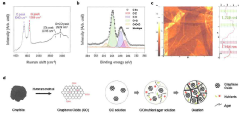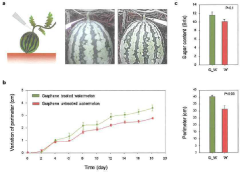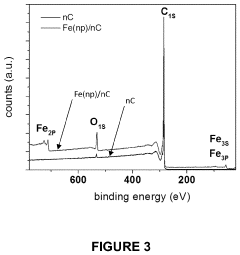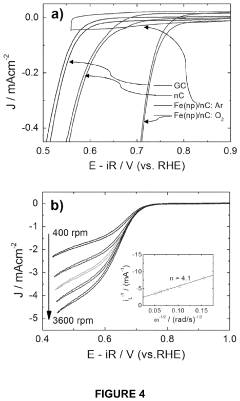Graphene Oxide: Sustainability in Modern Agriculture
Graphene Oxide in Agriculture: Background and Objectives
Graphene oxide, a derivative of graphene, has emerged as a promising material in various fields, including agriculture. The evolution of this technology can be traced back to the discovery of graphene in 2004, which sparked a revolution in materials science. As research progressed, scientists began exploring the potential applications of graphene and its derivatives in different sectors, with agriculture becoming a significant area of interest.
The development of graphene oxide for agricultural applications has been driven by the need for sustainable and efficient farming practices. As global population growth continues to put pressure on food production systems, there is an increasing demand for innovative solutions that can enhance crop yields, improve resource utilization, and reduce environmental impact. Graphene oxide, with its unique properties, has shown potential to address these challenges.
The technical evolution of graphene oxide in agriculture has focused on several key areas. These include its use as a nanofertilizer, a tool for pest management, a component in smart agriculture sensors, and a material for improving water purification and soil remediation. Each of these applications leverages the material's exceptional properties, such as its large surface area, high adsorption capacity, and ability to enhance plant growth and stress resistance.
The primary objectives of research on graphene oxide in agriculture are multifaceted. Firstly, there is a focus on developing more efficient and targeted delivery systems for nutrients and pesticides, which could significantly reduce the amount of chemicals used in farming. Secondly, researchers aim to harness graphene oxide's potential in creating advanced sensors for precision agriculture, enabling real-time monitoring of soil conditions, crop health, and environmental factors.
Another crucial objective is to explore graphene oxide's role in enhancing crop resilience to environmental stresses, such as drought, salinity, and extreme temperatures. This aspect of research is particularly important in the context of climate change and its impact on agriculture. Additionally, there is growing interest in utilizing graphene oxide for water purification and soil remediation, addressing critical issues of water scarcity and soil contamination in agricultural regions.
As research in this field progresses, the overarching goal is to develop sustainable, eco-friendly, and economically viable solutions that can be integrated into modern agricultural practices. This involves not only advancing the technology itself but also addressing challenges related to scalability, cost-effectiveness, and potential environmental impacts of graphene oxide applications in agriculture.
Market Demand for Sustainable Agricultural Solutions
The global agricultural sector is experiencing a significant shift towards sustainable practices, driven by increasing environmental concerns, resource scarcity, and the need for improved crop yields. This transition has created a substantial market demand for innovative solutions that can address these challenges effectively. Graphene oxide, with its unique properties and potential applications in agriculture, is emerging as a promising candidate to meet these sustainability requirements.
The market for sustainable agricultural solutions is expanding rapidly, with projections indicating substantial growth in the coming years. Farmers and agribusinesses are actively seeking technologies that can enhance crop productivity while minimizing environmental impact. This demand is fueled by several factors, including the need to feed a growing global population, combat climate change effects on agriculture, and reduce the use of harmful chemicals and pesticides.
Graphene oxide's potential in agriculture aligns well with these market needs. Its ability to improve soil quality, enhance water retention, and boost nutrient delivery systems makes it an attractive option for sustainable farming practices. Additionally, its potential as a nano-carrier for targeted pesticide and fertilizer delivery could significantly reduce chemical usage in agriculture, addressing both environmental and economic concerns.
The demand for graphene oxide in agriculture is also driven by the increasing focus on precision farming techniques. As farmers adopt more data-driven and technology-oriented approaches, materials like graphene oxide that can interface with sensors and smart farming systems are gaining traction. This integration potential opens up new market opportunities in the agricultural technology sector.
Furthermore, there is a growing consumer preference for sustainably produced food products. This trend is pushing food companies and retailers to source from farms that employ environmentally friendly practices. Consequently, technologies that can demonstrate tangible sustainability benefits, such as graphene oxide-based solutions, are likely to see increased adoption throughout the agricultural supply chain.
However, the market demand is not without challenges. The agricultural sector is often conservative in adopting new technologies, particularly those that require significant changes to established practices. There are also concerns about the long-term effects of nanomaterials on soil and plant health, which need to be addressed through rigorous research and field trials. These factors may initially slow market penetration but also present opportunities for companies that can effectively demonstrate the safety and efficacy of graphene oxide-based agricultural solutions.
In conclusion, the market demand for sustainable agricultural solutions presents a significant opportunity for graphene oxide applications. As research progresses and more practical applications are developed, the material's potential to address key sustainability challenges in agriculture is likely to drive its adoption across various farming systems and regions.
Current State and Challenges in Graphene Oxide Research
Graphene oxide (GO) research has made significant strides in recent years, particularly in its application to modern agriculture. The current state of GO research is characterized by a blend of promising advancements and persistent challenges. Researchers have successfully demonstrated GO's potential in enhancing crop growth, improving soil quality, and developing smart agricultural technologies.
One of the primary areas of progress is in the use of GO as a nano-fertilizer. Studies have shown that GO can significantly improve nutrient uptake in plants, leading to increased crop yields and enhanced resistance to environmental stresses. This application has garnered considerable attention due to its potential to address food security concerns in a sustainable manner.
Another notable advancement is the development of GO-based sensors for precision agriculture. These sensors can detect soil moisture levels, nutrient content, and even the presence of pathogens with high accuracy. This technology enables farmers to optimize resource use and implement targeted interventions, thereby reducing waste and environmental impact.
Despite these promising developments, several challenges remain in GO research for agricultural applications. One of the most pressing issues is the potential environmental impact of GO nanoparticles. While initial studies suggest low toxicity, the long-term effects of GO accumulation in soil and water systems are not yet fully understood. This uncertainty has led to calls for more comprehensive environmental impact assessments before widespread adoption.
Scalability and cost-effectiveness present another significant hurdle. While GO shows remarkable properties in laboratory settings, translating these benefits to large-scale agricultural applications remains challenging. The production of high-quality GO in quantities sufficient for widespread agricultural use is currently cost-prohibitive, limiting its practical implementation.
Additionally, there are concerns regarding the standardization of GO products for agricultural use. The variability in GO properties depending on production methods and starting materials can lead to inconsistent results in agricultural applications. Establishing industry standards for GO quality and characteristics is crucial for ensuring reliable performance across different agricultural contexts.
Regulatory frameworks for the use of nanomaterials in agriculture also pose a challenge. Many countries lack specific regulations for nanomaterials like GO in agricultural products, creating uncertainty for researchers and potential adopters. Developing appropriate regulatory guidelines that balance innovation with safety considerations is essential for the future of GO in agriculture.
Existing Graphene Oxide Solutions for Agriculture
01 Synthesis and production methods of graphene oxide
Various methods for synthesizing and producing graphene oxide are described, including chemical exfoliation, oxidation of graphite, and reduction processes. These techniques aim to create high-quality graphene oxide with controlled properties for different applications.- Synthesis and production methods of graphene oxide: Various methods for synthesizing and producing graphene oxide are described, including chemical exfoliation, oxidation of graphite, and reduction processes. These techniques aim to create high-quality graphene oxide with controlled properties for different applications.
- Applications of graphene oxide in energy storage devices: Graphene oxide is utilized in energy storage devices such as batteries and supercapacitors. Its unique properties, including high surface area and conductivity, make it an excellent material for improving the performance and efficiency of these devices.
- Functionalization and modification of graphene oxide: Various methods for functionalizing and modifying graphene oxide are explored to enhance its properties and tailor it for specific applications. These modifications can include chemical treatments, doping, and surface modifications to improve its performance in different fields.
- Graphene oxide-based composites and nanocomposites: The development of graphene oxide-based composites and nanocomposites is described, combining graphene oxide with other materials to create hybrid structures with enhanced properties. These composites find applications in various fields, including electronics, sensors, and structural materials.
- Characterization and analysis techniques for graphene oxide: Various characterization and analysis techniques are employed to study the properties and structure of graphene oxide. These methods include spectroscopic techniques, microscopy, and other analytical tools to understand the material's composition, morphology, and behavior.
02 Applications of graphene oxide in electronics and energy storage
Graphene oxide is utilized in electronic devices and energy storage systems due to its unique properties. It can be incorporated into batteries, supercapacitors, and other electronic components to enhance performance and efficiency.Expand Specific Solutions03 Functionalization and modification of graphene oxide
Techniques for functionalizing and modifying graphene oxide are explored to tailor its properties for specific applications. This includes chemical treatments, doping, and surface modifications to enhance its performance in various fields.Expand Specific Solutions04 Graphene oxide-based composites and materials
The development of graphene oxide-based composites and materials is discussed, focusing on combining graphene oxide with other substances to create novel materials with enhanced properties for applications in various industries.Expand Specific Solutions05 Characterization and analysis techniques for graphene oxide
Various methods and techniques for characterizing and analyzing graphene oxide are presented. These include spectroscopic, microscopic, and other analytical approaches to determine the structure, composition, and properties of graphene oxide materials.Expand Specific Solutions
Key Players in Graphene Oxide Agricultural Applications
The research on graphene oxide in modern agriculture is in its early stages, with significant potential for growth. The market size is expanding as sustainability becomes a key focus in agricultural practices. Technologically, it's still evolving, with varying levels of maturity across applications. Leading institutions like Centre National de la Recherche Scientifique and universities such as Bologna and Florida are driving fundamental research. Companies like BASF Corp. and Pioneer Hi-Bred International are exploring commercial applications. Emerging players from China, including Sichuan Institute of Graphene Industrial Technology and Guangdong University of Technology, are also making notable contributions, indicating a globally competitive landscape with diverse stakeholders from academia and industry.
Alma Mater Studiorum - Università di Bologna
BASF Corp.
Core Innovations in Graphene Oxide Synthesis and Application
- A composition comprising graphene oxide nanosheets is used in the growth medium or injected into the stem of crops to enhance characteristics such as flower number and fruit size, utilizing specific physicochemical properties for targeted delivery of plant growth promoters.
- A method involving the dissolution of nanographite intercalation compounds in aprotic organic solvents, followed by reaction with metal salts or complexes under inert conditions, without a reducing agent, to form nanographene-supported metal and/or metal oxide nanoparticles, allowing for precise control over particle size and distribution.
Environmental Impact of Graphene Oxide in Agriculture
The environmental impact of graphene oxide in agriculture is a critical consideration as this nanomaterial gains traction in modern farming practices. Graphene oxide's unique properties, such as its high surface area and excellent adsorption capabilities, make it a promising candidate for various agricultural applications. However, these same characteristics also raise concerns about its potential effects on ecosystems and human health.
One of the primary environmental benefits of graphene oxide in agriculture is its potential to reduce the use of conventional agrochemicals. By enhancing the efficiency of fertilizers and pesticides, graphene oxide-based formulations can lead to decreased chemical runoff into water bodies, potentially mitigating water pollution and eutrophication. Additionally, its use in soil remediation techniques shows promise in addressing contaminated agricultural lands, offering a sustainable approach to soil management.
However, the environmental risks associated with graphene oxide cannot be overlooked. The material's high mobility in soil and water systems raises concerns about its potential to accumulate in the environment. Studies have shown that graphene oxide can interact with soil microorganisms, potentially altering microbial communities that are crucial for soil health and nutrient cycling. The long-term effects of these interactions on soil ecosystems remain uncertain and require further investigation.
The potential for bioaccumulation of graphene oxide in plants and its subsequent entry into the food chain is another significant environmental concern. While some research suggests limited uptake by plants, the possibility of nanoparticle accumulation in edible plant tissues cannot be ruled out entirely. This raises questions about the long-term impact on biodiversity and the potential for biomagnification in higher trophic levels.
The fate of graphene oxide in the environment is also a subject of ongoing research. Its persistence and degradation pathways in soil and water systems are not fully understood, making it challenging to predict long-term environmental consequences. The potential for graphene oxide to act as a carrier for other pollutants, due to its high adsorption capacity, adds another layer of complexity to its environmental impact assessment.
As the agricultural use of graphene oxide expands, there is a growing need for comprehensive life cycle assessments to evaluate its overall environmental footprint. This includes considering the energy and resources required for production, as well as end-of-life management strategies. Developing sustainable disposal or recycling methods for graphene oxide-containing agricultural products will be crucial in minimizing its environmental impact.
In conclusion, while graphene oxide shows promise in enhancing agricultural sustainability, its environmental impact remains a complex and multifaceted issue. Balancing the potential benefits with the risks requires ongoing research, careful regulation, and the development of best practices for its use in agriculture. As the technology evolves, a precautionary approach coupled with rigorous scientific investigation will be essential in ensuring that the integration of graphene oxide in agriculture aligns with broader environmental sustainability goals.
Regulatory Framework for Nanomaterials in Agriculture
The regulatory framework for nanomaterials in agriculture is a complex and evolving landscape, reflecting the rapid advancements in nanotechnology and its potential applications in the agricultural sector. As graphene oxide emerges as a promising nanomaterial for sustainable agriculture, it becomes crucial to understand the existing regulations and potential future developments in this area.
Currently, the regulatory approach for nanomaterials in agriculture varies significantly across different regions and countries. In the European Union, the European Food Safety Authority (EFSA) has established guidelines for assessing the risks of nanomaterials in food and feed applications. These guidelines require manufacturers to provide detailed information on the physicochemical properties, toxicological profile, and potential environmental impacts of nanomaterials before they can be approved for use in agricultural products.
In the United States, the Environmental Protection Agency (EPA) regulates nanomaterials under the Toxic Substances Control Act (TSCA). The EPA has implemented specific reporting and recordkeeping requirements for companies manufacturing or processing nanoscale materials, including those intended for agricultural use. Additionally, the Food and Drug Administration (FDA) oversees the regulation of nanomaterials in food products and packaging, which may have implications for agricultural applications.
Internationally, the Organization for Economic Co-operation and Development (OECD) has been working on developing harmonized approaches for the safety assessment of nanomaterials. Their efforts aim to create a more consistent regulatory framework across different countries, facilitating international trade and ensuring a high level of environmental and human health protection.
As research on graphene oxide in agriculture progresses, it is likely that regulatory bodies will need to adapt their frameworks to address the unique properties and potential risks associated with this nanomaterial. This may involve developing specific guidelines for assessing the environmental fate and ecotoxicological impacts of graphene oxide when used in agricultural settings.
One of the key challenges in regulating nanomaterials like graphene oxide is the need for standardized testing methods and risk assessment protocols. Regulatory agencies are increasingly collaborating with research institutions and industry stakeholders to develop these standards, which will be crucial for ensuring the safe and responsible use of nanomaterials in agriculture.
Looking ahead, it is anticipated that regulations will evolve to address the long-term effects of nanomaterials on soil health, biodiversity, and ecosystem functioning. This may include requirements for monitoring programs to assess the accumulation of nanomaterials in agricultural environments over time. Additionally, as consumer awareness of nanotechnology in agriculture grows, there may be increased pressure for transparent labeling and disclosure of nanomaterial use in agricultural products.







